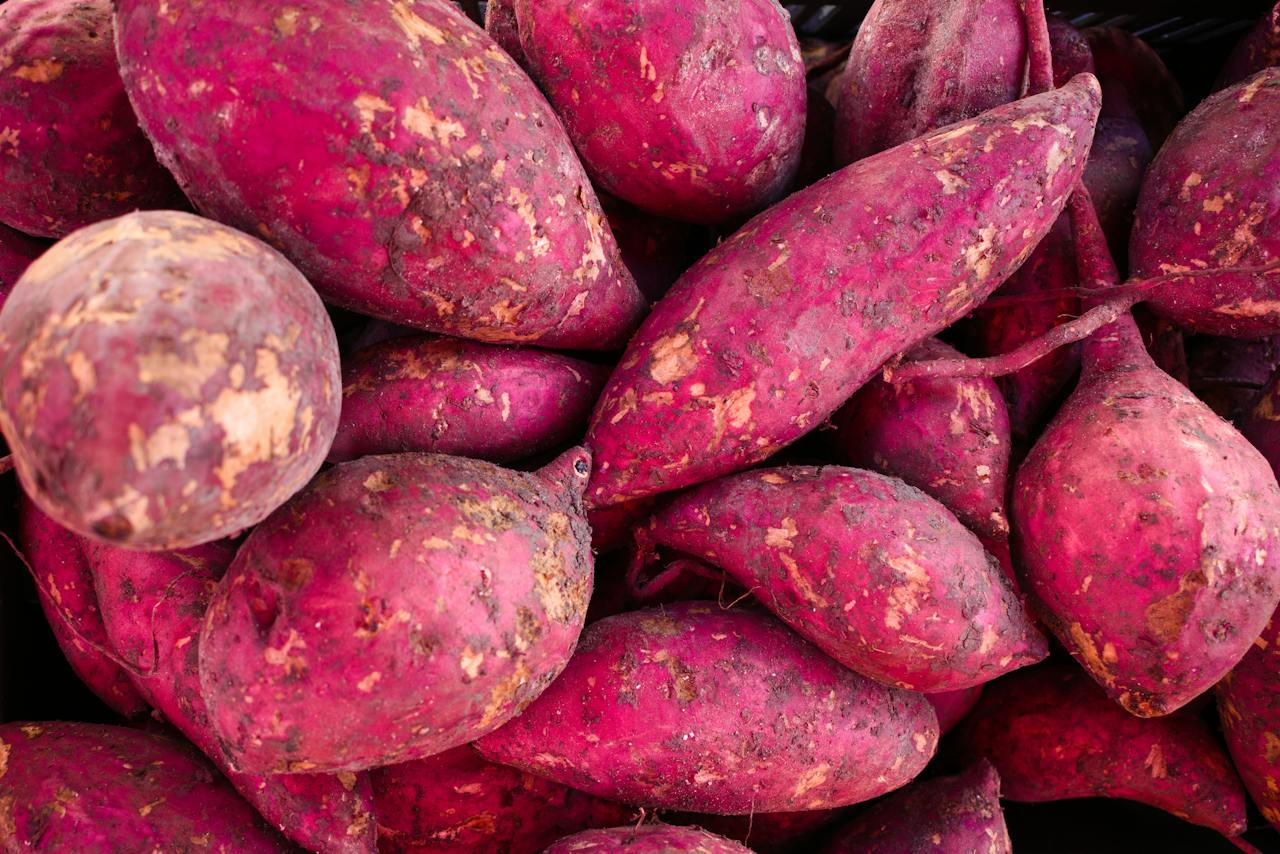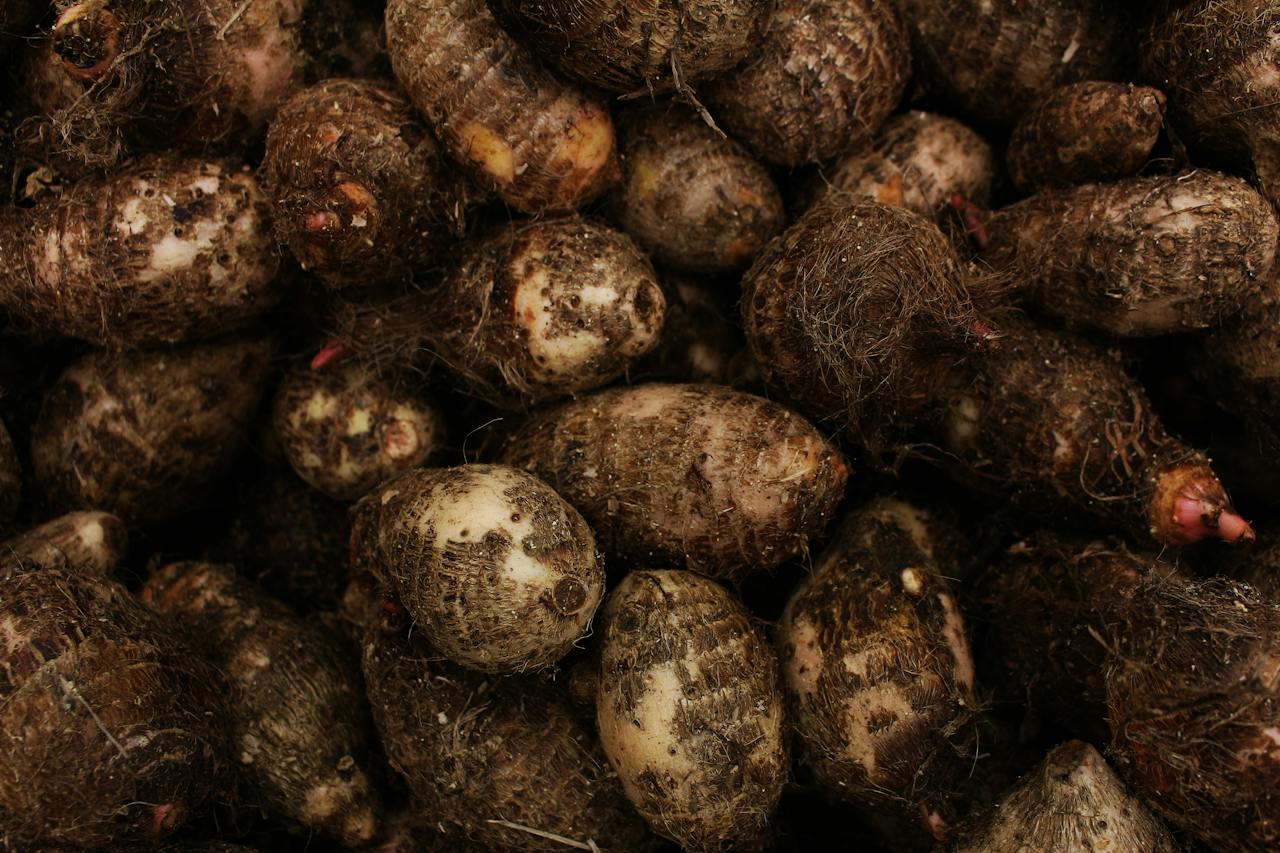Sweet Potato vs Yam: What Is the Difference?


Vegetable trivia: are sweet potatoes and yams the same? If you’re not entirely sure, you’re not alone. There is a common misconception that these are just two different names for the same vegetable. Despite their similar coloring, orange flesh, and oblong shape, sweet potatoes and yams are, in fact, different vegetables.
While they both fall under the category of root vegetables, they belong to separate plant families. Sweet potatoes are in the morning glory family (Convolvulaceae), and yams are a tuber of the tropical vine Dioscorea batas (a member of the Dioscoreaceae family).1 What’s more, these two veggies hail from totally different continents, with yams being native to Asia and Africa and sweet potatoes being native to South America.2
In this article, we’ll share how these two veggies stack up when it comes to things like calories, carbs, vitamins, minerals, and other phytonutrients.
High-Level Highlights
- Sweet potatoes contain more beta-carotene (vitamin A)
- Yams are higher in calories and carbohydrates
- Yams are high in minerals like potassium

Discover how your body responds to what you eat, and make small changes to hit your health goals
View PlansSweet Potato vs. Yam: Key Differences
If you’re planning any upcoming meals that call for sweet potatoes or yams, it’s important to know the difference. These two veggies have different tastes and textures, so grabbing the wrong one could definitely ruin the dish!
There are hundreds of different varieties of sweet potatoes and yams, so there can be quite a bit of variation, but yams are typically starchier and drier, while sweet potatoes tend to be more sweet and moist.
Yams and sweet potatoes also differ in appearance: yams have a rough brown skin, and white flesh, while sweet potatoes have orange skin with orange, purple, or white flesh.
Unlike sweet potatoes, true yams aren’t grown here in the United States, so they can be harder to find at an American grocery store. Unless you specifically sought out yams, which are usually found in an international market, chances are you’re eating sweet potatoes.1
Sweet Potato vs Yam: Uses
Both sweet potatoes and yams can be prepared in similar ways (boiling, baking, steaming, etc.); however, the end products will be different based on their flavor profiles. In the same way that you wouldn’t substitute a sweet potato with a russet potato (Russet potato pie, anyone?), you shouldn’t swap a sweet potato for a yam.
Due to their dry starchy nature, yams are traditionally included in savory dishes in Caribbean, Central American, West African, Asian, and Filipino cultures.3 Sweet potatoes, on the other hand, are softer and sweeter and can be used in dishes like the popular sweet potato marshmallow casserole, sweet potato pie, or sweet potato fries.
Sweet Potato vs. Yam Nutrition
Although both veggies are very close in fiber, protein, vitamin C, and magnesium, sweet potatoes are the healthier option because they are lower in overall calories, lower in carbohydrates, and higher in beta carotene (vitamin A).5, 6
Glycemic Index
The glycemic index is a measure of how quickly a specific food can spike your blood sugar. Ideally we want to prioritize foods that have lower glycemic indexes in order to keep your blood sugar balanced. The glycemic index of a food can change based on how it’s cooked, so there is typically a wide range with any food.
Sweet potatoes' glycemic index may range from 44 to 91. Try boiling an orange sweet potato for 30 minutes for a low-glycemic option. The glycemic index for this variety of sweet potato and cooking method is 46, whereas a roasted orange sweet potato has a glycemic index of 82.
Yams have similar disparities in glycemic indexes, as it depends on the variety of yams you consume and the cooking method. For yams, the glycemic index can range from 44 to 75.
Each individual has different reactions to foods, so we recommend experimenting to see if yams or sweet potatoes cause significant spikes for you.
Vitamins
Both veggies are nearly tied in vitamin C, but yams have slightly more folate and vitamin K.
Fiber
Sweet potatoes and yams are both good sources of fiber. With an average of 4g per 100g, they contribute to nearly 15% of your daily fiber needs.
Potassium
Potassium is an essential mineral and electrolyte required by all tissues in our bodies. Yams have more than double the amount of potassium as sweet potatoes, and 100g can provide 17% of the daily recommended value.
Which is Healthier: Sweet Potato or Yam?
In this battle of the healthiest root vegetable, the winner is the sweet potato. A helpful rule to remember when assessing produce is that bright or deep colors are often related to nutrient value. Sweet potatoes with yellow or orange hues have higher levels of beta-carotene (vitamin A) and phytonutrients called phenolic acids. Purple sweet potatoes are rich in another health-promoting compound called anthocyanins.4
The nutrients in sweet potatoes have been shown to have powerful antioxidant and anti-inflammatory effects, which reduce the risk of many chronic diseases.4 While yams are a good source of fiber and minerals, sweet potatoes are more nutrient-dense and lower in calories, ultimately making them the better choice.

Discover how your body responds to what you eat, and make small changes to hit your health goals
View PlansReferences
- https://loc.gov/everyday-mysteries/agriculture/item/what-is-the-difference-between-sweet-potatoes-and-yams/#:~:text=Yams%20are%20a%20monocot%20(a,Convolvulacea%20or%20morning%20glory%20family.
- https://www.eatingwell.com/article/8006059/sweet-potatoes-vs-yams-whats-the-difference/
- https://www.bonappetit.com/story/difference-between-sweet-potato-and-yam
- Laveriano-Santos EP, López-Yerena A, Jaime-Rodríguez C, González-Coria J, Lamuela-Raventós RM, Vallverdú-Queralt A, Romanyà J, Pérez M. Sweet Potato Is Not Simply an Abundant Food Crop: A Comprehensive Review of Its Phytochemical Constituents, Biological Activities, and the Effects of Processing. Antioxidants (Basel). 2022 Aug 25;11(9):1648. doi: 10.3390/antiox11091648. PMID: 36139723; PMCID: PMC9495970.
- https://fdc.nal.usda.gov/fdc-app.html#/food-details/170071/nutrients
- https://fdc.nal.usda.gov/fdc-app.html#/food-details/168482/nutrients
Frequently Asked Questions
Frequently Asked Questions
Is taro a yam or sweet potato?
Taro is neither a yam nor a sweet potato. While the three all fall under the root vegetable category, taro belongs to a separate vegetable family called araceae.
Is cassava the same as a yam?
Cassava is not the same as yams. It’s a starchy root vegetable similar to yams and sweet potatoes, but it belongs to a separate vegetable family called euphorbiaceae.
What are the three types of yams?
Three popular types of yams are the purple yam, Japanese yam, and jumbo yam.
What is the healthiest root vegetable?
Turmeric is widely considered to be the healthiest root vegetable. When deciding on which root vegetables to consume, it’s a good idea to choose brightly colored varieties (purple yam, sweet potato, purple potato, etc.) as these pigments represent the health-promoting phytonutrients present in the vegetable.

